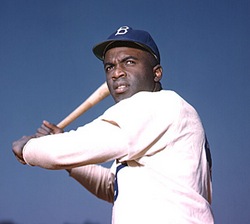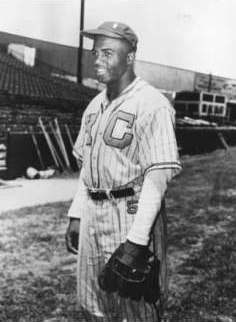

 Jackie Robinson
Jackie Robinson
Date and Place of Birth: January 31, 1919 Cairo, Georgia
Died:
October 24, 1972 Stamford, Connecticut
Baseball Experience: Major League
Position: Infield
Rank: Second Lieutenant
Military Unit: 761st Tank Battalion US Army
Area Served: United States
He graduated
from Dakota Junior High School in 1935 and enrolled at John Muir
High School where he played baseball, football, basketball, tennis,
and track and field.
In 1936, he
captured the junior boys singles championship in the annual Pacific
Coast Negro Tennis Tournament, starred as quarterback, and earned a
place on the annual Pomona baseball tournament all-star team, which
included future Baseball Hall of Famers Ted Williams and Bob Lemon.
Robinson
later attended Pasadena Junior College where he played both football
and baseball. He played quarterback and safety for the football
team, shortstop for the baseball team.
In 1938, he
was elected to the All-Southland Junior College baseball team and
selected as the region's Most Valuable Player. After leaving
Pasadena Junior College, Robinson chose to attend the University of
California, Los Angeles, where he became the school's first athlete
to win varsity letters in four sports: baseball, basketball,
football and track.
Robinson left
UCLA before completing his degree in 1941 and went to Hawaii to play
football for the semi-professional, racially integrated Honolulu
Bears. He returned to California on December 5, 1941 two days before
the Japanese attack on Pearl Harbor and was drafted the following
year.
On April 3, 1942,
Robinson entered the US Army, attended officer candidate school, and
was commissioned a second lieutenant in 1943. He served at Fort
Riley, Kansas in 1943 and then Fort Hood, Texas. Robinson was one of
the few African-American officers at Fort Hood and when he refused
to sit in the back of a military bus in 1944, he was subsequently
court martialed, but acquitted because the order was a violation of
War Department policy prohibiting racial discrimination in
recreational and transportation facilities on all US Army posts.
In the
summer of 1944, when Robinson was a lieutenant in the 761st Tank
Battalion at Fort Hood, a broken ankle he had suffered playing
football back in 1932 kept him from going overseas with his outfit.
"My CO sent me to the hospital for a physical checkup," he told
Yank magazine on November 23, 1945, "and they changed my status
to permanent limited service. After that I kicked around the tank
destroyers doing a little bit of everything. Then I wound up as a
lieutenant in an infantry battalion at Camp Breckinridge. In October
1944 I was given a 30-day leave and put on inactive duty. I'm still
on inactive duty. What I'd like to know is, do I have to go back
into active duty to get separated or will they just notify me that
I'm out?"
He received a
medical discharge on November 28, 1944.
Branch
Rickey, president of the Brooklyn Dodgers began to scout the young
Negro League player and signed him on October 23, 1945. Robinson was
became the first African-American in 57 years to break the Organized
Baseball color line.
"I realize what I'm going into," he said at the
time. "I realize what it means to me and to my race and to baseball,
too. I'm very happy for this chance and I can only say that I'll do
my best to make the grade."
The young
infielder reported to the Montreal Royals in 1946. He lead the
International League with a .349 batting average, and made his major
league debut with Brooklyn on April 15, 1947, winning The Sporting
News Rookie of the Year Award.
In ten major
league seasons he appeared in six World Series and six All-Star
games, and led the National League in batting with a .342 average in
1949, clinching the National League Most Valuable Player Award.
Robinson
retired on January 5, 1957. He had wanted to manage or coach in the
major leagues, but no offers came his way. Instead, he became
a vice-president for the Chock Full O' Nuts corporation.
Robinson was
suffering from high blood pressure and diabetes, and he was all but
blind when he died from a heart attack at the age of 53.
In March
1984, President Ronald Reagan posthumously awarded Robinson the
Presidential Medal of Freedom.
On April 15,
1997, the 50th anniversary of his debut, Major League Baseball
retired the number 42, the number Robinson wore, in recognition of
his accomplishments both on and off the field.
On October
29, 2003, the United States Congress posthumously awarded Robinson
the Congressional Gold Medal, the highest award the Congress can
bestow. Robinson's widow accepted the award in a ceremony in the
Capitol Rotunda on March 2, 2005.
On April 15,
2007, the 60th anniversary of Robinson's major league debut, Major
League Baseball invited players to wear the number 42 just for that
day to commemorate Robinson. More than 200 players wore number 42,
including the entire rosters of the Los Angeles Dodgers, Houston
Astros, Philadelphia Phillies, St. Louis Cardinals, Milwaukee
Brewers, and Pittsburgh Pirates.
Some of the above
information was obtained from the Jackie Robinson page on
www.wikipedia.com.
Created May
18, 2007. Updated July 12, 2007.
Copyright © 2024 Gary Bedingfield (Baseball
in Wartime). All Rights Reserved.


